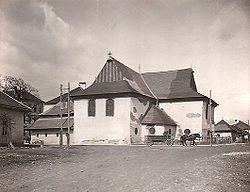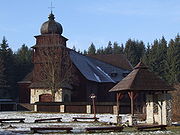
Articular church
Encyclopedia



Wood
Wood is a hard, fibrous tissue found in many trees. It has been used for hundreds of thousands of years for both fuel and as a construction material. It is an organic material, a natural composite of cellulose fibers embedded in a matrix of lignin which resists compression...
en churches for Evangelical
Protestantism
Protestantism is one of the three major groupings within Christianity. It is a movement that began in Germany in the early 16th century as a reaction against medieval Roman Catholic doctrines and practices, especially in regards to salvation, justification, and ecclesiology.The doctrines of the...
congregations erected under the terms of the Congress of Sopron
Sopron
In 1910 Sopron had 33,932 inhabitants . Religions: 64.1% Roman Catholic, 27.8% Lutheran, 6.6% Jewish, 1.2% Calvinist, 0.3% other. In 2001 the city had 56,125 inhabitants...
of 1681. At this congress, summoned by the Habsburg
Habsburg
The House of Habsburg , also found as Hapsburg, and also known as House of Austria is one of the most important royal houses of Europe and is best known for being an origin of all of the formally elected Holy Roman Emperors between 1438 and 1740, as well as rulers of the Austrian Empire and...
Emperor
Holy Roman Emperor
The Holy Roman Emperor is a term used by historians to denote a medieval ruler who, as German King, had also received the title of "Emperor of the Romans" from the Pope...
Leopold I
Leopold I, Holy Roman Emperor
| style="float:right;" | Leopold I was a Holy Roman Emperor, King of Hungary and King of Bohemia. A member of the Habsburg family, he was the second son of Emperor Ferdinand III and his first wife, Maria Anna of Spain. His maternal grandparents were Philip III of Spain and Margaret of Austria...
, permission was for the first time granted for followers of the Augsburg
Augsburg Confession
The Augsburg Confession, also known as the "Augustana" from its Latin name, Confessio Augustana, is the primary confession of faith of the Lutheran Church and one of the most important documents of the Lutheran reformation...
and Calvinist confessions to erect and maintain churches within the Emperor's dominions. As this permission was contained in Articles (i.e. clause
Clause
In grammar, a clause is the smallest grammatical unit that can express a complete proposition. In some languages it may be a pair or group of words that consists of a subject and a predicate, although in other languages in certain clauses the subject may not appear explicitly as a noun phrase,...
s) 35 and 36 of the Congress's deliberations, the term 'articular' was applied to them.
Background
The Sopron Congress was called against a background of social unrest, including civil revolt, religious friction and continuing threat of invasion from TurkeyTurkey
Turkey , known officially as the Republic of Turkey , is a Eurasian country located in Western Asia and in East Thrace in Southeastern Europe...
. The Emperor therefore determined that it was necessary to make concessions to his Protestant population to secure its loyalty.
However, severe restrictions were placed on the Protestant congregations. No more than two churches could be built in each administrative region — in areas of strategic importance, the limit was one church — and buildings had to be outside city walls. Further regulations determined siting, and building procedures. As a consequence, the articular churches were all built of wood, mostly in the period 1681-1730. There were originally 38 such churches, nearly all located in the region of today's Slovakia
Slovakia
The Slovak Republic is a landlocked state in Central Europe. It has a population of over five million and an area of about . Slovakia is bordered by the Czech Republic and Austria to the west, Poland to the north, Ukraine to the east and Hungary to the south...
.
Many of the churches displayed extraordinary ingenuity in their construction. They were typically decorated within by painting, often of a trompe l'oeil
Trompe l'oeil
Trompe-l'œil, which can also be spelled without the hyphen in English as trompe l'oeil, is an art technique involving extremely realistic imagery in order to create the optical illusion that the depicted objects appear in three dimensions.-History in painting:Although the phrase has its origin in...
nature giving the impression of marble columns or drapery.
The articular churches today
Five articular churches survive today in Slovakia. Perhaps the most well-known is the church in KežmarokWooden articular church in Kežmarok
The Wooden articular church in Kežmarok is a wooden church in Kežmarok, Slovakia. The local Lutherans built it during a period of religious persecution, when they were allowed to erect only wooden churches. That is why even nails were made exclusively of wood...
, built between 1718 and 1730 under the direction of Juraj Müttermann, replacing an earlier structure of 1687. Others are at Leštiny
Leštiny
Leštiny is a village and municipality in Dolný Kubín District in the Žilina Region of northern Slovakia.-Geography:The municipality lies at an altitude of 586 metres and covers an area of 6.939 km². It has a population of about 225 people....
(1689, restored 1860s), Hronsek
Hronsek
Hronsek is a village and municipality of the Banská Bystrica District in the Banská Bystrica Region of Slovakia.-History:In historical records, the village was first mentioned in 1500, and it has changed its name many times during its History: Hronsek is a village and municipality of the Banská...
(1725-6, a wood-framed structure now without internal wall-paintings), Istebné
Istebné
Istebné is a village and municipality in Dolný Kubín District in the Zilina Region of northern Slovakia....
(built between 1686 and 1731) and Svätý Kríž (about 1693). The latter church was originally located at the village of Paludza, which was submerged in the Liptovská Mara
Liptovská Mara
Liptovská Mara is a reservoir in northern Slovakia, on the Váh river near Liptovský Mikuláš, in the Liptov region. The dam is named after one of the inundated villages....
reservoir
Reservoir
A reservoir , artificial lake or dam is used to store water.Reservoirs may be created in river valleys by the construction of a dam or may be built by excavation in the ground or by conventional construction techniques such as brickwork or cast concrete.The term reservoir may also be used to...
in the late 1970s. Between 1974 and 1977 the church was carefully dismantled and restored before being rebuilt in Svätý Kríž, where it was reconsecrated in 1982. The churches in Kežmarok
Kežmarok
Kežmarok is a town in the Spiš region of eastern Slovakia , on the Poprad River.-History:...
, Leštiny and Hronsek are now part of a UNESCO
UNESCO
The United Nations Educational, Scientific and Cultural Organization is a specialized agency of the United Nations...
World Heritage Site
World Heritage Site
A UNESCO World Heritage Site is a place that is listed by the UNESCO as of special cultural or physical significance...
called Carpathian Wooden Churches
Carpathian Wooden Churches
Roman Catholic wooden church of St. Francis of Assisi in Hervartov has a Gothic character as represented by its tall but narrow structure unusual for a wooden church. It was built in the second half of the 15th century and thus represents the oldest of its type in Slovakia...
, declared in 2008.

